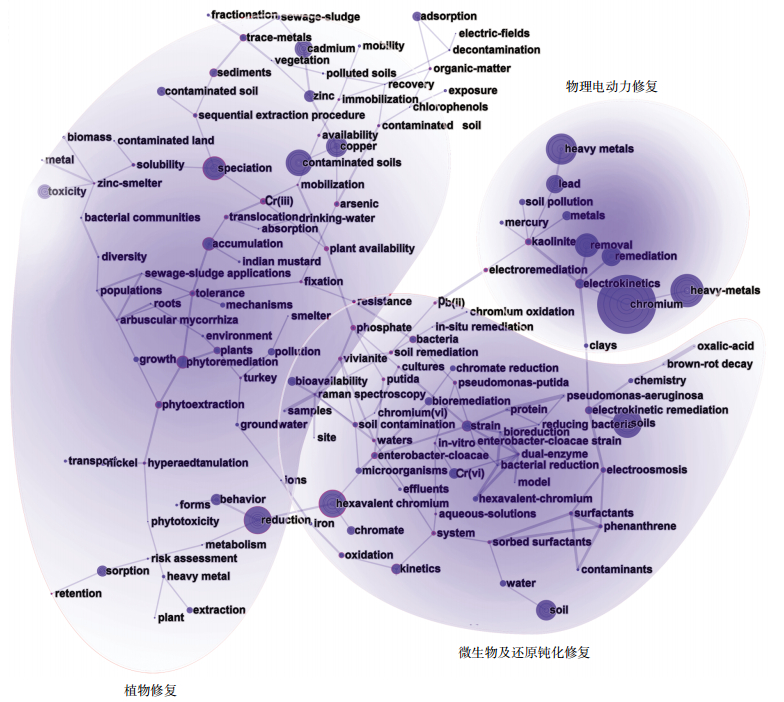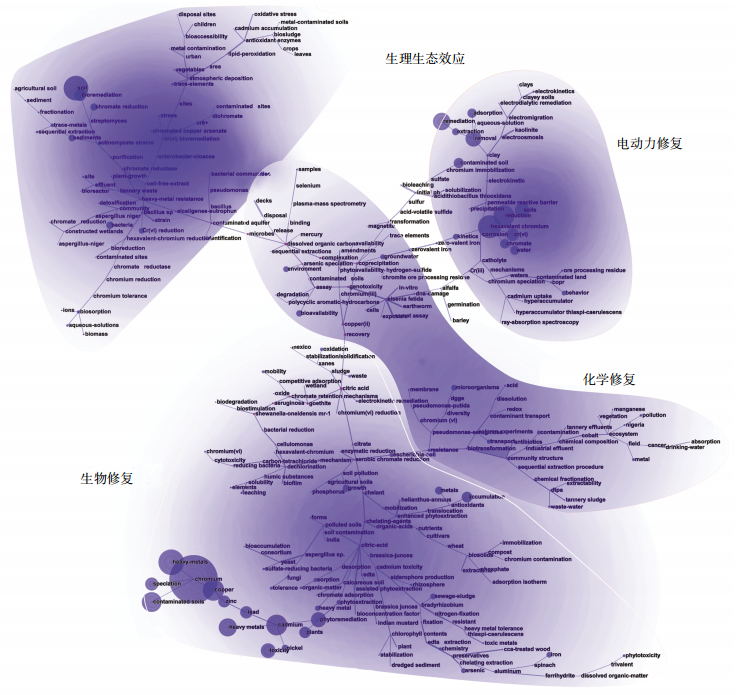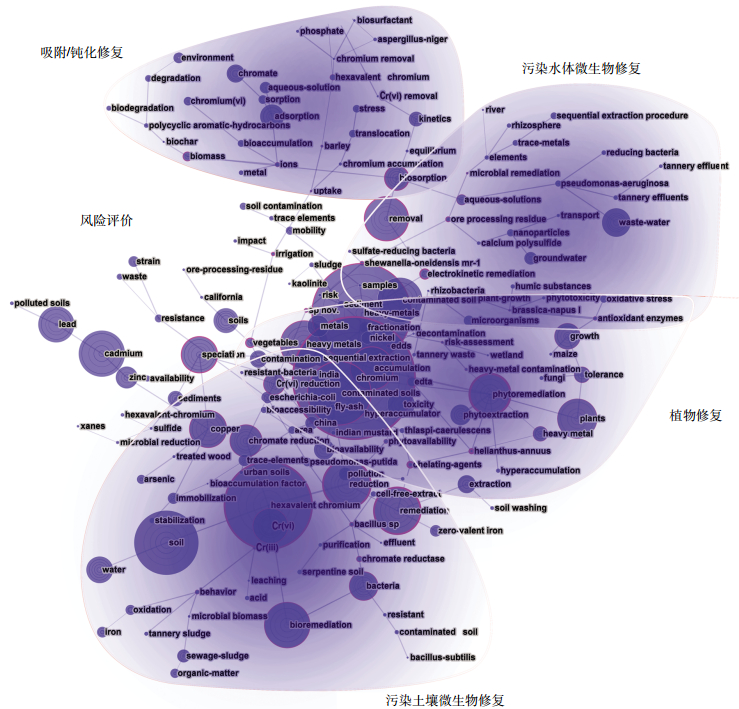文章信息
- 朱宇恩, 张倩茹, 张维荣, 姜凯钦, 侯贺斌, 李铃, 李华
- ZHU Yu-en, ZHANG Qian-ru, ZHANG Wei-rong, JIANG Kai-qin, HOU He-bin, LI Ling, LI Hua
- 基于文献计量的Cr污染土壤修复发展历程剖析 (2001-2015年)
- Historical venation of chromium-contaminated soil remediation in the past 15 years based on the bibliometric analysis (2001-2015)
- 农业环境科学学报, 2017, 36(3): 409-419
- Journal of Agro-Environment Science, 2017, 36(3): 409-419
- http://dx.doi.org/10.11654/jaes.2016-1083
文章历史
- 收稿日期: 2016-08-22
2. 四川省资阳中学, 四川 资阳 641300
2. Ziyang Middle School in Sichuan Province, Ziyang 641300, China
土壤既是人类赖以生存的立地条件,又是重要的环境要素。土壤的污染必将导致生态破坏并威胁人类生存[1]。由于污灌、含Cr工业生产等过程中Cr的排放,使农田与场地Cr污染在世界各地均有一定的积存。据2014年《全国土壤污染状况调查公报》,我国土壤重金属污染的耕地面积点位超标率为19.4%,Cr污染耕地超标面积148.68万hm2。每年堆存的未经无害化处置的数万吨铬渣也会导致场地土壤污染[2],这使得以工业遗留场地为特征的Cr污染场地逐渐增多,并引起广泛关注。
Cr污染土壤的修复作为降低生态风险、保障公众健康的重要手段,在数十年的发展中涵盖了物理、化学、生物、农业生态、电动力学诸多方面[3],不断引入新的研究思路、方法和手段,修复技术体系不断完善;而且多学科的交叉、新材料的引入也推动着Cr污染土壤修复技术的快速前进。在快速推进的背景下,有必要认真梳理Cr污染土壤修复的发展脉络,聚焦Cr污染土壤修复中的“关键过程”与“需要突破的瓶颈”,探究Cr污染土壤修复新材料的演化规律,进而增强Cr污染土壤修复研究与技术发展的源动力。
为了系统、全面地了解Cr污染土壤修复的研究进展,本文利用文献计量法对2001—2015年与Cr污染土壤修复相关的文献进行计量分析,总结21世纪以来Cr污染土壤修复的发展历程和研究进展,以期为科研工作者提供研究方向及热点参考。
1 数据来源与统计方法 1.1 数据来源本文在Web of ScienceTM核心合集数据库中以“Chromium”和“Contaminated soil”为关键词进行主题检索作为文献分析的数据来源。根据Cr污染土壤文献历年的发文量(图 1),本文最终选定的分析时间跨度为2001.01.01—2015.12.31。所有文献检索日期为2016年5月29日。

|
| 图 1 1990—2015年Cr污染土壤修复相关文献历年发文量 Figure 1 The number of published literatures on chromium-contaminated soil remediation during 1990—2015 |
利用引文网络分析工具CiteSpace Ⅲ进行文献数据挖掘和可视化分析[4]。
在进行关键词共现分析之前,对关键词进行聚类,使用LLR算法提取研究前沿术语,再对聚类词进行Timeline分析,根据生成的TimeLine图谱,结合该图谱与共被引关键词的中心性和相关性进行时间分配,将研究时间划分成三个阶段,分别是2001—2005、2006—2010年和2010—2015年。
而后进行关键词共现分析。时间划分(Timing Slicing)设置为2001—2015年,时间节点(Years Per Slice)设为5年,术语来源(Term Source)勾选为标题(Title)、摘要(Abstract)、著者(DE)、关键字(ID),阈值设置为top=30[5]。得出关键词的频次并生成Cr污染土壤修复的可视化知识图谱。
2 结果与讨论 2.1 近15年Cr污染土壤修复历程分析近15年与Cr污染土壤修复相关文献共检索到1189篇。从文献计量网络图谱(图 2至图 4)看出,3个阶段的研究节点逐渐增多,各聚类圈间的交叉融合显著增强,表明Cr污染土壤修复的相关研究逐渐扩展和深入。2001—2015年间,在修复机理上,Cr污染土壤修复从Cr污染生物效应研究转向迁移转化基础上的毒理评价,进而向探索修复阈值的合理性和风险评价方向发展。在修复历程上,Cr污染土壤修复从以生物修复和电动力修复为中心的应用可行性研究阶段,发展为生物修复、电动力修复、土壤淋洗、钝化还原等修复技术的多元化阶段,进而向以技术改进和材料创新为导向的强化修复和联合修复技术方向发展,且环境友好型修复材料和因地制宜的规模化应用成为关注焦点。表 1为近15年Cr污染土壤修复领域前15位高频关键词。

|
| 图 2 2001—2005年Cr污染土壤修复文献计量网络图谱 Figure 2 The bibliometric network map on chromium-contaminated soil remediation during 2001—2005 |

|
| 图 3 2006—2010年Cr污染土壤修复文献计量网络图谱 Figure 3 The bibliometric network map on chromium-contaminated soil remediation during 2006—2010 |

|
| 图 4 2011—2015年Cr污染土壤修复文献计量网络图谱 Figure 4 The bibliometric network map on chromium-contaminated soil remediation during 2011—2015 |

|
文献计量网络图谱(图 2)显示,该时期Cr污染土壤修复研究主要集中于电动力修复和生物修复,同时在Cr污染生物效应方面也有一定程度的研究。“Speciation”、“Toxicity”、“Behavior”、“Bioavailability”等高频关键词表明,在该时期内,Cr的生物效应以及迁移转化特性作为修复技术的理论基础,成为研究重点[6]。生物修复研究以植物提取修复和微生物钝化还原修复为研究重点。植物提取修复中,除了对超积累植物进行筛选外,还通过使用螯合剂(EDTA等)提高植物修复效率,增强植物修复的应用可行性[7]。在微生物还原钝化修复聚类圈中,“Bacteria”、“Enterobacter-cloacae”、“Pseudomonas-putida”等多次出现,说明该时期以探究具有Cr污染土壤修复功能的微生物种类及其修复机理为研究重点[8]。生物修复技术作为该时期的研究热点之一,受到修复植株矮小、菌群适应性差等限制[8],应用进展缓慢,但对于修复部分低浓度Cr污染土壤仍具有一定的可行性[9]。电动力修复技术以利用直流电清除酸洗土壤中重金属为研究重点,但由于不适用于渗透性较高、传导性较差的砂性土壤[10-11],其应用范围受到一定的限制,有关该修复技术的完善仍在继续。
2.1.2 以生物修复技术为重点,联合修复初现端倪的研究时期(2006—2010年)文献计量网络图谱(图 3)显示,该时期Cr污染土壤修复的研究重点从Cr在土壤中迁移转化规律的探索逐渐向修复技术研究转变。关键词“Toxicity”高频(43次)出现,表明该阶段Cr的生理毒理效应与生态危害仍是研究重点,主要通过研究Cr胁迫植物的生理表征进行毒理评价[12-14]。“Chromate reduction”出现频次的大幅增加表明科研人员更加重视Cr还原研究,“Zero valent iron”的出现意味着Fe赋存形态对修复效率的影响受到关注。在修复技术上,主要集中于“生物修复”、“电动力修复”和“化学修复”三方面。生物修复聚类圈中(图 3),植物和微生物的一体化交融表明植物-微生物联合修复技术受到广泛关注,该阶段在通过盆栽实验研究Cr生物积累、转化和降解规律的同时,开始扩大耐性修复细菌的筛选范围并注重生物异位修复的应用可行性研究[15-16]。电动力修复除电解液的优化与逼近阳极等新型电极技术的应用外,以电动-可渗透反应墙为代表的联用技术开始出现并迅速发展。化学修复技术主要研究两方面:一是淋洗技术,着重于天然螯合剂的选择和淋洗技术与设备的改进;二是氧化还原修复,其中以纳米零价铁和FeSO4应用为重点的铁基修复剂研究备受关注。随着研究的不断深入,修复剂的种类和数量愈加丰富,修复技术之间的联用开始出现。
2.1.3 新技术、新材料的探索以及联合修复技术多元化的研究时期(2011—2015年)文献计量网络图谱(图 4)显示,该时期研究节点增多,研究内容具有“单一修复技术创新化,联合修复技术多元化”的特点。植物修复聚类圈中,“Helianthus annuus”、“Indian mustard”等以节点形式出现,表明对新型修复植物的筛选和传统修复植物的研究仍在继续,也更加注重解决超富集植物生长缓慢、生物量小以及难以大规模推广等问题[17],同时将重点转移到通过辅助增效助剂提高植物的修复效率上。微生物修复领域,研究人员为解决微生物变异、吸附量有限、环境适应性差等问题[18],探究了不同菌种的修复能力差异,并尝试与基因工程、多孔吸附材料以及植物修复等技术联合修复。文献计量图谱(图 4)中微生物修复聚类圈和植物修复聚类圈的交叉重叠也印证了这一点。在电动力修复方面,研究重点转移到通过电学参数调节、修复剂强化以及电动力与其他技术的联合来提高修复效率[19-20]。土壤淋洗修复主要通过寻找新型淋洗剂提高萃取效率[21],而以超富集植物提取液为淋洗剂的植物-土壤淋洗联合修复技术成为新的生长点。钝化还原修复注重新型修复材料的探索,羧甲基纤维素、改性吸附剂、石墨烯、纳米材料及负载纳米材料等的研发成为Cr污染土壤修复材料的突破尝试。同时,这一时期也更加注重生态与健康风险评价,并对合理确定修复阈值展开研究。
2.2 近15年Cr污染土壤修复技术分析表 2为近15年Cr污染土壤7种修复技术关键词汇列表。如表 2所示,Cr污染土壤修复技术发展的阶段性特征显著,表现在修复方法递进式的精细化、多元化,新材料、新工艺、新技术的跨领域引进与融合爆发式发展,而技术的针对性地域化适应、材料的功能优化、环境友好化成为技术发展的突破核心。

|
Cr污染土壤植物、微生物修复技术中,修复植物的筛选经历了超积累植物-耐性植物-地域性乡土植物的阶段,修复中更加注重植物生态功能的实现、景观效应的体现和经济实用性,能源植物与观赏植物的出现尤为引人关注。微生物修复技术菌种筛选从以杆菌属为主的还原细菌阶段,到放线菌、固化真菌与耐Cr还原细菌(杆菌、单胞菌为主)多种并存的多元化筛选阶段,再到基因工程菌为核心的生物遗传工程、菌种地域化适应及微生物参与的多种联合修复阶段,筛选范围逐步扩大、应用针对性逐步增强。
土壤淋洗修复技术中,淋洗液从单一的无机化学洗液向无机、有机(表面活性剂)、生物(还原菌、生物表面活性剂、酶类)多元化方向发展。
电动力修复技术最初研究以电解液的筛选调节为主,随后发展为电解液优化、电极设置优化与技术更新、电压调节(叠加电场)、助剂强化等方面,近五年更加注重电流电压控制、新能源的应用以及与其他修复技术的联用,预计下一阶段将向低能耗、高效能的方向发展。
钝化还原修复技术中,钝化修复材料从传统的石灰、水泥、堆肥、磷酸盐逐渐转变为活性炭、生物炭、羟基磷灰石并向改性材料发展,还原修复材料从硫酸亚铁、零价铁向纳米零价铁、纳米TiO2等纳米材料转变,进而再向由壳聚糖、羟甲基纤维素、金属有机骨架材料等有机材料负载的纳米材料,甚至到双金属纳米材料发展。新型修复材料的发现以及多种修复材料的改性将成为接下来研究的重点和热点,同时环境友好型材料将被更多关注。
在联合修复技术方面,2001—2005年间对联合修复的研究较少,2006—2010年间出现了植物-微生物以及电动力-可渗透反应墙等少数联合修复技术及案例,近5年联合修复随着新技术的引入和已有修复技术的成熟而快速发展,联合修复趋向多样化和复杂化。修复技术也出现了微波/超声修复技术以及光催化技术等利用光能量进行修复的案例。
总之,近15年Cr污染土壤修复技术在修复材料的筛选研发和修复技术的创新上呈簇状发展模式,并呈现“低成本、低能耗、低环境污染、高利用价值”的“三低一高”发展态势。
3 结论(1)文献计量分析表明,2001—2015年间Cr污染土壤修复历程由早期的以电动力修复、生物修复主导的应用可行性研究,逐渐转向土壤淋洗修复、钝化还原修复以及以筛选修复菌种与修复植物为核心的生物修复技术研究时期,进而向多技术联合修复、新技术和新材料的探索研究阶段发展,学科交叉融合不断增强。
(2)Cr污染土壤修复技术的研究主要聚焦于4个维度:生物修复技术(植物和微生物修复技术)、电动力修复技术、土壤淋洗修复技术和钝化还原修复技术。从总体来看,4种技术都以修复效率的提高为目标,进行了修复材料、修复参数、修复生理生态影响、地域化适应的多领域研究,研究思路从单一修复技术向联合修复技术方向发展,研究理念从单一修复能力与效率研究向低能耗、低污染方面转变。
(3)随着修复机理研究的深入,基于迁移转化与生态毒理的污染生物效应评估逐步展开,生态和健康风险评价成为合理确定修复阈值的重要依据。
(4)新材料研发、多技术联合与地域化适用将成为下一阶段的研究重点,修复材料的纳米化制备、有机改性、负载强化与环境友好将成为技术突破点,而修复技术的深度融合与地域化适应是实际应用阶段需突破的瓶颈。
| [1] | 串丽敏, 郑怀国, 赵同科, 等. 基于Web of Science数据库的土壤污染修复领域发展态势分析[J]. 农业环境科学学报, 2016, 35(1): 12–20. CHUAN Li-min, ZHENG Huai-guo, ZHAO Tong-ke, et al. Trends in research on contaminated soil remediation based on Web of Science database[J]. Journal of Agro-Environmental Science, 2016, 35(1): 12–20. |
| [2] | 孟凡生. 中国铬渣污染场地土壤污染特征[J]. 环境污染与防治, 2016, 38(6): 50–53. MENG Fan-sheng. Pollution charateristics of soils polluted by chromium slag in China[J]. Environmental Pollution and Control, 2016, 38(6): 50–53. |
| [3] | 王鑫. 铬污染土壤的修复技术研究综述[J]. 环境工程, 2015, 33(Suppl): 847–849. WANG Xin. Review on remediation technologies on chromium contaminated soil[J]. Environmental Engineering, 2015, 33(Suppl): 847–849. |
| [4] | 干文芝, 胡宗达, 任永宽, 等. 基于文献计量学的国际土壤呼吸研究态势分析[J]. 西南农业学报, 2013, 26(3): 1105–1111. GAN Wen-zhi, HU Zong-da, REN Yong-kuan, et al. Bibliometrical analysis of soil respiration based on bibliometric[J]. Southwest China Journal of Agricultural Sciences, 2013, 26(3): 1105–1111. |
| [5] | 樊一阳, 许京京. 基于CiteSpace文献计量法的石墨烯研究文献可视化图谱分析[J]. 现代情报, 2015, 35(8): 81–91. FAN Yi-yang, XU Jing-jing. Visualization map analysis of literatures on graphene research based on bibliometrics of CiteSpace[J]. Modern Information, 2015, 35(8): 81–91. |
| [6] | 李晶晶, 彭恩泽. 综述铬在土壤和植物中的赋存形式及迁移规律[J]. 工业安全与环保, 2005, 31(3): 31–33. LI Jing-jing, PENG En-ze. Summarization on the existing form and transferring rules of chromium in soil[J]. Industrial Safety and Environmental Protection, 2005, 31(3): 31–33. |
| [7] | Turgut C, Katie P M, Cutright T J. The effect of EDTA and citric acid on phytoremediation of Cd, Cr, and Ni from soil using Helianthus annuus[J]. Environmental Pollution, 2004, 131(1): 147–154. DOI:10.1016/j.envpol.2004.01.017 |
| [8] | Jeyasingh J, Philip L. Bioremediation of chromium contaminated soil:Optimization of operating parameters under laboratory conditions[J]. Journal of Hazardous Materials, 2005, 118(1): 113–120. |
| [9] | Mulligan C N, Yong R N, Gibbs B F. Remediation technologies for metal-contaminated soils and groundwater:An evaluation[J]. Geoenvironmental Engineering, 2001, 60(1/2/3/4): 193–207. |
| [10] | 周东美, 邓昌芬. 重金属污染土壤的电动修复技术研究进展[J]. 农业环境科学学报, 2003, 22(4): 505–508. ZHOU Dong-mei, DENG Chang-fen. Review:Electrokinetic remediation of heavy metal contaminated soil[J]. Journal of Agro-Environmental Science, 2003, 22(4): 505–508. |
| [11] | 罗启仕, 张锡辉, 王慧, 等. 非均匀电动力学修复技术对土壤性质的影响[J]. 环境污染治理技术与设备, 2004, 5(4): 40–45. LUO Qi-shi, ZHANG Xi-hui, WANG Hui, et al. Influence of non-uniform electrokinetic remediation technology on soil properties[J]. Techniques and Equipment for Environmental Pollution Control, 2004, 5(4): 40–45. |
| [12] | Akinci I E, Akinci S. Effect of chromium toxicity on germination and early seedling growth in melon (Cucumis melo L.)[J]. African Journal of Biotechnology,, 2010, 929(29): 4589–4594. |
| [13] | Maisto G, Manzo S, De N F. Assessment of the effects of Cr, Cu, Ni and Pb soil contamination by ecotoxicological tests[J]. Journal of Environmental Monitoring Jem, 2011, 13(11): 3049–3056. DOI:10.1039/c1em10496a |
| [14] | Lone M I, He Z L, Stoffella P J, et al. Phytoremediation of heavy metal polluted soils and water:Progresses and perspectives[J]. Journal of Zhejiang University Science B, 2008, 9(3): 210–220. DOI:10.1631/jzus.B0710633 |
| [15] | 赵光辉. 六价铬还原菌剂载体研究及初步应用实验[J]. 环境保护科学, 2011, 37(2): 41–43. ZHAO Guang-hui. Research on the carriers of chromium (Ⅵ) reduction agent and its initial application experiments[J]. Environmental Protection Science, 2011, 37(2): 41–43. |
| [16] | Lebeau T, Braud A, Jézéquel K. Performance of bioaugmentation-assisted phytoextraction applied to metal contaminated soils:A review[J]. Environmental Pollution, 2008, 153(3): 497–522. DOI:10.1016/j.envpol.2007.09.015 |
| [17] | Krzciuk K, Gałuszka A. Prospecting for hyperaccumulators of trace elements:A review[J]. Critical Reviews in Biotechnology, 2014, 35(4): 1–11. |
| [18] | Dhal B, Thatoi H N, Das N N, et al. Chemical and microbial remediation of hexavalent chromium from contaminated soil and mining/metallurgical solid waste:A review[J]. Journal of Hazardous Materials, 2013, s250/251(2): 272–291. |
| [19] | Meng F S, Wang Y Y, Leng L L, et al. Effect of applied voltage on the electrokinetic removal of chromium from soils[J]. Advanced Materials Research, 2011, 414: 144–149. DOI:10.4028/www.scientific.net/AMR.414 |
| [20] | Li D, Niu Y Y, Fan M, et al. Focusing phenomenon caused by soil conductance heterogeneity in the electrokinetic remediation of chromium (Ⅵ)-contaminated soil[J]. Separation & Purification Technology, 2013, 120: 52–58. |
| [21] | Zhang Y K, Qi S, Chen H H. A review of remediation of chromium contaminated soil by washing with chelants[J]. Advanced Materials Research, 2014, 838-841: 2625–2629. |
| [22] | Bennett L E, Burkhead J L, Hale K L, et al. Analysis of transgenic Indian mustard plants for phytoremediation of metal-contaminated mine tailings[J]. Journal of Environmental Quality, 2003, 32(2): 432–440. DOI:10.2134/jeq2003.4320 |
| [23] | Aldrich M V, Gardeatorresdey J L, Peraltavidea J R, et al. Uptake and reduction of Cr (Ⅵ) to Cr (Ⅲ) by mesquite (Prosopis spp.):Chromate-plant interaction in hydroponics and solid media studied using XAS[J]. Environmental Science & Technology, 2003, 37(9): 1859–1864. |
| [24] | 张学洪, 罗亚平, 黄海涛, 等. 一种新发现的湿生铬超积累植物:李氏禾 (Leersia hexandra Swartz)[J]. 生态学报, 2006, 26(3): 950–953. ZHANG Xue-hong, LUO Ya-ping, HUANG Hai-tao, et al. Leersia hexandra Swartz:A newly discovered hygrophyte with chromium hyperaccumulator properties[J]. Acta Ecologica Sinica, 2006, 26(3): 950–953. |
| [25] | 郑施雯, 魏远, 顾红波, 等. 铬污染地区植物重金属含量特征与耐性植物筛选研究[J]. 林业科学研究, 2011, 24(2): 205–211. ZHENG Shi-wen, WEI Yuan, GU Hong-bo, et al. Characteristics of heavy metals in plants growing on Cr contaminated area and Cr-tolerant plants screening[J]. Forest Research, 2011, 24(2): 205–211. |
| [26] | Yadav S K, Dhote M, Kumar P, et al. Differential antioxidative enzyme responses of Jatropha curcas L. to chromium stress[J]. Journal of Hazardous Materials, 2010, 180(1/2/3): 609–615. |
| [27] | Buendíagonzález L, Orozcovillafuerte J, Cruzsosa F, et al. Prosopis laevigata a potential chromium (Ⅵ) and cadmium (Ⅱ) hyperaccumulator desert plant[J]. Bioresource Technology, 2010, 101(15): 5862–5867. DOI:10.1016/j.biortech.2010.03.027 |
| [28] | Łukaszewicz J P, Wesołowski R P, Cyganiuk A. Enrichment of Salix viminalis wood in metal ions by phytoextraction[J]. Polish Journal of Environmental Studies, 2009, 18(3): 507–511. |
| [29] | Subhashini V, Swamy A V V S. Phytoremediation of cadmium and chromium contaminated soils by Cyperus rotundus L.[J]. American International Journal of Research in Science, Technology, Engineering & Mathematics, 2014, 6(7): 97–101. |
| [30] | Oliveira L M D, Ma L Q, Santos J A, et al. Effects of arsenate, chromate, and sulfate on arsenic and chromium uptake and translocation by arsenic hyperaccumulator Pteris vittata L.[J]. Environmental Pollution, 2014, 184C(1): 187–192. |
| [31] | Xing W, Wu H, Hao B, et al. Bioaccumulation of heavy metals by submerged macrophytes:Looking for hyperaccumulators in eutrophic lakes[J]. Environmental Science & Technology, 2013, 47(9): 4695–4703. |
| [32] | Madhavi V, Reddy A V B, Reddy K G, et al. An overview on research trends in remediation of chromium[J]. Research Journal of Recent Sciences, 2013, 2(1): 71–83. |
| [33] | Li C, Xiao B, Wang Q H, et al. Phytoremediation of Zn-and Cr-contaminated soil using two promising energy grasses[J]. Water, Air, & Soil Pollution, 2014, 225(7): 1–12. |
| [34] | 陆小成, 陈露洪, 徐泉, 等. 污染土壤电动修复增强方法研究进展[J]. 环境污染治理技术与设备, 2005, 6(1): 14–24. LU Xiao-cheng, CHEN Lu-hong, XU Quan, et al. Progress on enhancement methods for electrokinetic remediation of contaminated soil[J]. Techniques and Equipment for Environmental Pollution Control, 2005, 6(1): 14–24. |
| [35] | 周东美, 仓龙, 邓昌芬. 过氧化氢对铬在黄棕壤中电动过程的影响[J]. 土壤学报, 2005, 42(1): 59–63. ZHOU Dong-mei, CANG Long, DENG Chang-fen. Electrokinetic processes of chromium in yellow brown soil as affected by hydrogen peroxide[J]. Acta Pedologica Sinica, 2005, 42(1): 59–63. |
| [36] | 马莉, 张国庆, 曾彩明. 化学强化剂在电动修复技术中的应用研究进展[J]. 化工进展, 2008, 27(1): 38–44. MA Li, ZHANG Guo-qing, ZENG Cai-ming. Progress on electrokinetic remediation technologies of contaminated soil and perspective[J]. Chemical Industry and Engineering Progress, 2008, 27(1): 38–44. |
| [37] | 路平, 冯启言, 李向东, 等. 交换电极法强化电动修复铬污染土壤[J]. 环境工程学报, 2009, 3(2): 354–358. LU Ping, FENG Qi-yan, LI Xiang-dong, et al. Improvement in electrokinetic remediation of chromium contaminated soil with polarity exchange technique[J]. Chinese Journal of Environmental Engineering, 2009, 3(2): 354–358. |
| [38] | 薛浩, 孟凡生, 王业耀, 等. 酸化-电动强化修复铬渣场地污染土壤[J]. 环境科学研究, 2015, 28(8): 1317–1323. XUE Hao, MENG Fan-sheng, WANG Ye-yao, et al. Remediation of chromium residue-contaminated soil by preacidification electrokinetic remediation[J]. Research of Environmental Sciences, 2015, 28(8): 1317–1323. |
| [39] | 付融冰, 刘芳, 马晋, 等. 可渗透反应复合电极法对铬 (Ⅵ) 污染土壤的电动修复[J]. 环境科学, 2012, 33(1): 280–285. FU Rong-bing, LIU Fang, MA Jin, et al. Remediation of chromium (Ⅵ) contaminated soils using permeable reactive composite electrodes technology[J]. Chinese Journal of Environmental Science, 2012, 33(1): 280–285. |
| [40] | Zhang S, Zhang J, Cheng X, et al. Electrokinetic remediation of soil containing Cr (Ⅵ) by photovoltaic solar panels and a DC-DC converter[J]. Journal of Chemical Technology and Biotechnology, 2015, 90(4): 693–700. DOI:10.1002/jctb.2015.90.issue-4 |
| [41] | Urvashi T, Datta M. Reducation of toxic chromium and atrial localization of chromium reductase activity in bacterial isolate DM1[J]. World Journal of Microbiology & Biotechnology, 2005, 21(6/7): 891–899. |
| [42] | Guha H, Jayachandran K, Maurrasse F. Kinetics of chromium (Ⅵ) reduction by a type strain Shewanella alga under different growth conditions[J]. Environmental Pollution, 2001, 115(2): 209–218. DOI:10.1016/S0269-7491(01)00108-7 |
| [43] | Obraztsova A Y, Francis C A, Tebo B M. Sulfur disproportionation by the facultative anaerobe pantoea agglomerans SP1 as a mechanism for chromium (Ⅵ) reduction[J]. Geomicrobiology Journal, 2002, 19(1): 121–132. DOI:10.1080/014904502317246219 |
| [44] | Oves M, Khan M S, Zaidi A. Chromium reducing and plant growth promoting novel strain Pseudomonas aeruginosa, OSG41 enhance chickpea growth in chromium amended soils[J]. European Journal of Soil Biology, 2013, 56(2): 72–83. |
| [45] | 肖伟, 王磊, 李倬锴, 等. 六价铬还原细菌Bacillus cereus S5.4还原机理及酶学性质研究[J]. 环境科学, 2008, 29(3): 751–755. XIAO Wei, WANG Lei, LI Zhuo-kai, et al. Mechanisms and enzymatic characters of hexavalent chromium reduction by Bacillus cereus S5.4[J]. Environmental Science, 2008, 29(3): 751–755. |
| [46] | Goulhen F, Gloter A, Guyot F, et al. Cr (Ⅵ) detoxification by Desulfovibrio vulgaris strain Hildenborough:Microbe-metal interactions studies[J]. Applied Microbiology and Biotechnology, 2006, 71(6): 892–897. DOI:10.1007/s00253-005-0211-7 |
| [47] | Rahman A, Nahar N, Nawani N N, et al. Bioremediation of hexavalent chromium (Ⅵ) by a soil-borne bacterium, Enterobacter cloacae B2-DHA[J]. Journal of Environmental Science & Health Part A Toxic/hazardous Substances & Environmental Engineering, 2015, 50(11): 1136–1147. |
| [48] | Wang T, Sun H, Mao H, et al. The immobilization of heavy metals in soil by bioaugmentation of a UV-mutant Bacillus subtilis 38 assisted by NovoGro biostimulation and changes of soil microbial community[J]. Journal of Hazardous Materials, 2014, 278: 483–490. DOI:10.1016/j.jhazmat.2014.06.028 |
| [49] | Polti M A, Aparicio J D, Benimeli C S, et al. Simultaneous bioremediation of Cr (Ⅵ) and lindane in soil by actinobacteria[J]. International Biodeterioration & Biodegradation, 2014, 88(2): 48–55. |
| [50] | Mistry K, Desai C, Lal S, et al. Hexavalent chromium reduction by Staphylococcus sp. isolated from Cr (Ⅵ) contaminated land fill[J]. International Journal of Biotechnology & Biochemistry, 2011, 6(1): 117–131. |
| [51] | Sen M, Dastidar M G, Roychoudhury P K. Hexavalent chromium reduction and its distribution in the cell and medium by chromium resistant fusarium solani[J]. International Journal of Engineering & Technology Innovation, 2013, 3(1): 1–9. |
| [52] | Iram S, Zaman A, Iqbal Z, et al. Heavy metal tolerance of fungus isolated from the soil contaminated with sewage and industrial wastewater[J]. Polish Journal of Environmental Studies, 2013, 22(3): 691–697. |
| [53] | 刘磊, 胡少平, 陈英旭, 等. 淋洗法修复化工厂遗留地重金属污染土壤的可行性[J]. 应用生态学报, 2010, 21(6): 1537–1541. LIU Lei, HU Shao-ping, CHEN Ying-xu, et al. Feasibility of washing as a remediation technology for the heavy metals-polluted soils left by chemical plant[J]. Chinese Journal of Applied Ecology, 2010, 21(6): 1537–1541. |
| [54] | 赵庆辉.铬污染土壤原位修复技术研究[D].杨凌:西北农林科技大学, 2011. ZHAO Qing-hui. In situ treatment of soil contaminated with chromium:A case study[D]. Yangling:Northwest A & F University, 2011. |
| [55] | 王鑫, 梁成华, 陈辉, 等. 低分子量有机酸对棕壤吸附Cr (Ⅵ) 特性的影响研究[J]. 环境科学与技术, 2014(8): 13–16. WANG Xin, LIANG Cheng-hua, CHEN Hui, et al. Effects of low molecular weight organic acids on brown soil adsorption characteristics of Cr (Ⅵ)[J]. Environmental Science & Technology, 2014(8): 13–16. |
| [56] | 曹晓雅, 曹俊雅, 李媛媛, 等. 表面活性剂和硫酸盐还原菌去除污染土壤中的Cr6+[J]. 过程工程学报, 2014, 14(1): 84–89. CAO Xiao-ya, CAO Jun-ya, LI Yuan-yuan, et al. Removal of Cr6+ from contaminated soil by surfactants and sulfate-reducing bacteria[J]. The Chinese Journal of Process Engineering, 2014, 14(1): 84–89. |
| [57] | KiliçE, Font J, Puig R, et al. Chromium recovery from tannery sludge with saponin and oxidative remediation[J]. Journal of Hazardous Materials, 2011, 185(1): 456–462. DOI:10.1016/j.jhazmat.2010.09.054 |
| [58] | Ma Y, Li F, Jiang Y, et al. Remediation of Cr (Ⅵ)-contaminated soil using the acidified hydrazine hydrate[J]. Bulletin of Environmental Contamination and Toxicology, 2016, 97(3): 1–3. |
| [59] | Misra V, Pandey S D. Remediation of contaminated soil by amendment of nonhumus soil with humus-rich soil for better metal immobilization[J]. Bulletin of Environmental Contamination and Toxicology, 2004, 73(3): 561–567. |
| [60] | 金漫彤, 董海丽, 楼敏晓. 土壤聚合物固化飞灰与水泥固化的比较研究[J]. 硅酸盐通报, 2008, 27(5): 904–908. JIN Man-tong, DONG Hai-li, LOU Xiao-min, et al. Research into the comparison between geopolymer solidification fly ash and cement solidification fly ash[J]. Bulletin of the Chinese Ceramic Society, 2008, 27(5): 904–908. |
| [61] | Misra V, Chaturvedi P K. Plant uptake/bioavailability of heavy metals from the contaminated soil after treatment with humus soil and hydroxyapatite[J]. Environmental Monitoring & Assessment, 2007, 133(1/2/3): 169–176. |
| [62] | 李琛.有机酸还原六价铬反应动力学及其影响因素研究[D].南京:南京农业大学, 2006. LI Chen. Study on kinetics of chromium (Ⅵ) reduction by organic acids and theirs impact factors[D]. Nanjing:Nanjing Agricultural University, 2006. |
| [63] | Manning B A, Kiser J R, Kwon H, et al. Spectroscopic investigation of Cr (Ⅲ)-and Cr (Ⅵ)-treated nanoscale zerovalent iron[J]. Environmental Science & Technology, 2007, 41(2): 586–592. |
| [64] | 李雪婷.改性粘土矿物修复重金属污染底泥的稳定性研究[D].合肥:安徽建筑大学, 2015. LI Xue-ting. Study on the stabilization of heavy metals for contaminated river sediment by modified clay minerals[D]. Hefei:Anhui Jianzhu University, 2015. |
| [65] | 白雪, 贺璐, 赵树兰, 等. 改性纳米碳黑隔层对络合剂存在下草坪堆肥基质重金属淋溶的影响[J]. 天津师范大学学报 (自然科学版), 2016, 36(4): 59–63. BAI Xue, HE Lu, ZHAO Shu-lan, et al. Effects of modified nano-carbon black barriers on the leaching of heavy metals mobilized by chelators in turfgrass compost medium[J]. Journal of Tianjin Normal University (Natural Science Edition), 2016, 36(4): 59–63. |
| [66] | Su H, Fang Z, Tsang P E, et al. Stabilisation of nanoscale zero-valent iron with biochar for enhanced transport and in-situ remediation of hexavalent chromium in soil[J]. Environmental Pollution, 2016, 214: 94–100. DOI:10.1016/j.envpol.2016.03.072 |
| [67] | Jabeen H, Chandra V, Jung S, et al. Enhanced Cr (Ⅵ) removal using iron nanoparticle decorated graphene[J]. Nanoscale, 2011, 3(9): 3583–3585. DOI:10.1039/c1nr10549c |
| [68] | Zhu F, Li L, Ma S, et al. Effect factors, kinetics and thermodynamics of remediation in the chromium contaminated soils by nanoscale zero valent Fe/Cu bimetallic particles[J]. Chemical Engineering Journal, 2016, 302: 663–669. DOI:10.1016/j.cej.2016.05.072 |
| [69] | Wang Y, Fang Z, Kang Y, et al. Immobilization and phytotoxicity of chromium in contaminated soil remediated by CMC-stabilized nZVI[J]. Journal of Hazardous Materials, 2014, 275(2): 230–237. |
| [70] | Chrysochoou M, Johnston C P, Dahal G. A comparative evaluation of hexavalent chromium treatment in contaminated soil by calcium polysulfide and green-tea nanoscale zero-valent iron[J]. Journal of Hazardous Materials, 2012, 201/202(1): 33–42. |
| [71] | Brose D A, James B R. Hexavalent chromium reduction in solution and in chromite ore processing residue-enriched soil by tartaric acid with isopropyl alcohol and divalent manganese as co-reductants[J]. Journal of Environmental Quality, 2013, 42(42): 766–773. |
| [72] | 李东, 黄彦, 聂杨, 等. 高浓度铬污染土壤水浸泡与电动修复联合处理实验[J]. 环境工程学报, 2010, 4(11): 2579–2584. LI Dong, HUANG Yan, NIE Yang, et al. Water dipping and electrokinetic joined remediation of a heavily chromium-contaminated soil[J]. Chinese Journal of Environmental Engineering, 2010, 4(11): 2579–2584. |
| [73] | Sung M, Lee C Y, Lee S Z. Combined mild soil washing and compost-assisted phytoremediation in treatment of silt loams contaminated with copper, nickel, and chromium[J]. Journal of Hazardous Materials, 2011, 190(1/2/3): 744–754. |
| [74] | 王婷.高效诱变菌与生物炭复合修复重金属污染土壤的研究[D].天津:南开大学, 2013. WANG Ting. The bioremediation of heavy metal contaminated soil by bioaugmentation of an active mutant bacterium assisted by biochar[D]. Tianjin:Nankai University, 2013. |
| [75] | Li J S, Xue Q, Wang P, et al. Enhanced washing for Cr (Ⅵ) removal from contaminated soil using EDTA and microwave radiation[J]. Environmental Earth Sciences, 2015, 74(3): 1–6. |
| [76] | Cappai G, De G G, Muntoni A, et al. Combined use of a transformed red mud reactive barrier and electrokinetics for remediation of Cr/As contaminated soil[J]. Chemosphere, 2011, 86(4): 400–408. |
| [77] | 吴风光.微波辐射修复Cr (Ⅵ) 污染土壤的研究[D].长沙:湖南大学, 2013. WU Feng-guang. Research of repairing soil contaminated hexavalent chromium using microwave[D]. Changsha:Hunan University, 2013. |
| [78] | 屈学理.碳酸钠溶液解毒铬渣及堆肥修复铬污染土壤的研究[D].长沙:中南大学, 2011. QU Xue-li. Study on COPR detoxification by Na2CO3 solution and chromium contaminated soil remediation by compost[D]. Changsha:Central South University, 2011. |
 2017, Vol. 36
2017, Vol. 36




